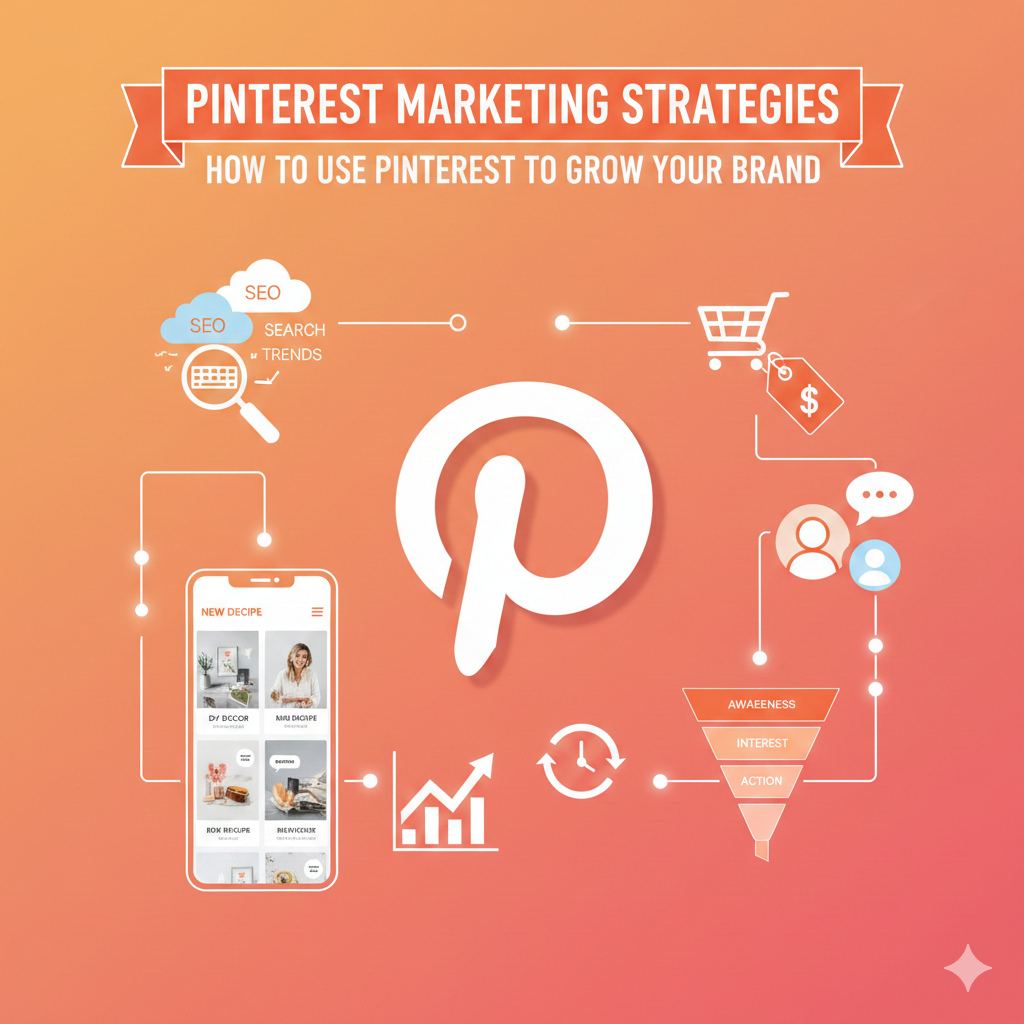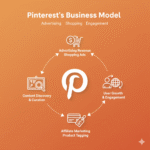Pinterest marketing works best when you combine SEO-focused Pins, high-quality visuals, keyword-rich boards, shoppable product Pins, consistent posting, and audience-focused idea pins. Pinterest is a visual search engine, so you win by optimizing for intent.
Now let’s go deeper into a full Pinterest marketing strategy in a simple and practical way.
What Makes Pinterest Different for Marketing?
Pinterest is not purely a social media platform.
It functions more like a visual search engine, which means:
- Users come with purpose and intent.
- Users actively search for ideas.
- Users save Pins to plan future purchases.
This mindset makes Pinterest one of the highest-converting platforms for niches like:
- Home décor
- Fashion
- Beauty
- Food
- Travel
- DIY
- Parenting
- Wellness
- Event planning
- eCommerce
Your strategy must focus on keywords + visuals + consistency.
Pinterest Marketing Strategies (Complete Guide)
Let’s break down the most effective strategies into easy-to-follow steps.
1. Master Pinterest SEO (The Foundation of Everything)
Pinterest behaves like Google — it ranks Pins based on keywords, relevance, and engagement. You cannot win Pinterest without proper SEO.
Use Keyword Research for Pinterest
Before creating a Pin, search for terms your audience uses:
- Search bar suggestions
- Pinterest Trends tool
- Idea Pins from competitors
- Related Pins under each keyword
Find 5–10 keywords and use them across:
- Pin title
- Pin description
- Board title
- Board description
- Alt text
Add Keywords Naturally
Pinterest doesn’t like keyword stuffing.
- Write descriptions like you’re explaining the idea to a friend.
- Example: “Modern kitchen décor ideas for small apartments” instead of “kitchen décor, modern kitchen, kitchen design, small kitchen ideas”
Create Niche-Specific Boards
Boards are like categories.
- Examples: Minimalist Home Decor, Summer Fashion Ideas, DIY Crafts for Beginners, Small Bedroom Inspiration, Healthy Vegetarian Recipes
- Use keywords in: Board name, Board cover, Board description
- Pinterest reads everything and ranks you accordingly.
2. Create High-Quality, Aesthetic Pins
Pinterest is visual-first, so your Pin design matters as much as your keyword strategy.
Use Vertical Pins Only
- Recommended size: 1000 × 1500 px
- Vertical Pins get more saves and impressions.
Strong, Clean, Minimal Design Works Best
Keep these rules:
- Use readable fonts
- Use 2–3 colors max
- Add whitespace
- Use high-resolution images
- Keep text short and bold
Add Text Overlays for Context
- Examples: “10 Small Bedroom Decor Ideas”, “7 Easy Healthy Breakfasts”, “How to Style Oversized Shirts”
- Text overlays increase CTR because users immediately know what the Pin is about.
Maintain Brand Consistency
Use the same:
- Color palette
- Fonts
- Visual mood
- Layout patterns
- This builds brand recognition across thousands of Pins.
3. Use Idea Pins (Pinterest’s Most Powerful Format)
Idea Pins are Pinterest’s version of story-style content — and they are pushed massively because Pinterest wants creators.
Why Idea Pins Matter
- They get huge organic reach
- They appear in search
- They live forever (not 24 hours)
- Pinterest uses them to show fresh ideas
- Brands can collaborate with creators through Idea Pins
Where to Use Idea Pins
- Step-by-step tutorials
- Before/after ideas
- Fashion lookbooks
- Mini guides
- Recipes
- DIY workflows
- Idea Pins increase: Saves, Impressions, Follower growth, Discoverability.
- And once your traffic grows, your normal Pins also rank higher.
4. Convert With Pinterest Shopping Features
Pinterest is becoming a shopping platform. If you sell products, this is a goldmine.
Claim Your Website
This ensures:
- Pinterest trusts your domain
- Your Pins rank better
- You unlock analytics
- You become eligible for shopping features
Use Product Rich Pins
Rich Pins pull product details automatically:
- Price
- Title
- Description
- Availability
- This increases CTR and conversions.
Upload Your Product Catalog
- If you use Shopify/WooCommerce, connect your store.
- Pinterest will create shoppable pins for all your products.
Focus on Lifestyle Imagery
- People save “ideas,” not plain product photos.
- Example: Instead of showing a lamp → show “Cozy bedroom lighting setup”.
5. Write Engaging Pin Titles & Descriptions
Pinterest gives high importance to written metadata.
Use Clear, Benefit-Based Titles
- Examples: “10 Modern Kitchen Decor Ideas for Small Homes”, “7 Healthy Breakfast Recipes Under 15 Minutes”, “Simple Summer Outfit Ideas for Men”
Use Long Descriptions
- Aim for 180–250 characters with keywords naturally blended.
Add a CTA (Subtle but Strong)
- Examples: “Tap to read full guide”, “Visit website for complete tutorial”, “See product details inside”
6. Consistency Matters (Even More Than Followers)
Pinterest pushes fresh content.
Post Daily or 3–5 Times a Week
You don’t need to post 20 Pins a day. Pinterest values quality over quantity.
- Suggested: 1–2 new Pins daily, 1 Idea Pin every 2–3 days, 1–2 product Pins every week
Re-Pin Your Best Content
Pins live for years. Bring old Pins back to life by:
- Re-creating new designs
- Refreshing titles
- Re-pinning to new boards
7. Use Pinterest Analytics to Improve Strategy
Your analytics tells you exactly what works.
Monitor These Key Metrics
- Impressions
- Saves
- Outbound clicks
- Engagement rate
- Profile visits
- Top performing boards
- High-ranking keywords
Double Down on What Performs
If “Blue Kitchen Decor Ideas” is going viral — create:
- More blue-themed boards
- Similar style pins
- Idea pins on the same theme
- Pinterest rewards creators who amplify successful content.
8. Collaborate With Influencers (Pinterest Creators)
Creators on Pinterest play a huge role in discovery.
Why Collaborations Work
- Creators produce high-quality Idea Pins
- Their content appears on home feed and search
- Users trust creator recommendations
- Pinterest boosts creator-led content
Types of Campaigns
- Sponsored Idea Pins
- Product usage tutorials
- Before–after transformations
- Aesthetic moodboards
- Gift guides
- Try-on videos
- These collaborations directly lead to: Traffic, Saves, Purchases.
9. Use Pinterest Trends to Predict What’s Next
Pinterest is a future-planning platform. People save Pins for: Upcoming seasons, Festivals, Weddings, Holidays, Travel plans.
Use These Tools
- Pinterest Trends
- Seasonal search spikes
- Monthly keyword calendars
Create Content Before Trends Peak
- Example: Create “Christmas Decor Ideas” in October, Create “Summer Fashion” in February, Create “Monsoon Recipes” in May.
- Early posting = higher ranking + more saves.
10. Use Community Engagement (Light but Helpful)
Pinterest is not heavy on social interaction, but engagement still helps.
Do These Small Steps
- Save Pins in your niche daily
- Follow relevant creators
- Reply to Idea Pin comments
- Engage with brands
- Comment lightly on top Pins
- Pinterest sees this activity as “account relevance.”
11. Optimize Your Pinterest Profile
Your profile decides whether users follow you or not.
Use a Clear, Keyword-Based Name
- Example: Instead of: PratsDigital Use: PratsDigital – Marketing Tips, SEO & eCommerce
Use a Clean Bio
- Explain what you post and who it helps.
Add a Professional Profile Image
- Prefer: Logo, Headshot, Clear branding
Add a Banner Highlighting Your Best Niche
- Use Canva to create a board cover for your top-performing category.
12. Promote Pins (Paid Strategy for Faster Growth)
Pinterest ads can help you scale faster.
Best Ad Formats
- Promoted Pins
- Video Ads
- Shopping Ads
- Collection Ads
- Carousel Ads
Best Campaign Goals
- Traffic
- Conversions
- Catalog sales
- Brand awareness
Start With Small Budget
- Even ₹300–₹500/day can test performance.
13. Repurpose Content Smartly
You don’t need to create everything from scratch.
Convert Blog Posts → Multiple Pins
If you write one blog, create:
- 5–10 Pins
- 1 Idea Pin
- 1 vertical infographic
Convert Videos → Idea Pins
- Take short clips and convert them into step-by-step Pins.
14. Use Seasonal + Evergreen Balance
Pinterest has two types of winning content:
- Evergreen Content: Small bedroom ideas, Healthy recipes, Simple hairstyles. These bring traffic every month.
- Seasonal Content: Diwali decor ideas, Christmas cookies, Summer outfits. These spike every year.
- Use both for long-term and short-term reach.
15. Build a Pinterest Funnel
Pinterest is not just for traffic — it can be a full sales funnel.
Funnel Example
- Awareness: Idea Pins → Board Saves
- Interest: Blog posts → Product collections
- Desire: Product rich Pins → UGC Idea Pins
- Action: Product page → Checkout
- Pinterest works amazing for top-of-the-funnel and mid-funnel growth.
Conclusion: Pinterest Marketing Is All About Intent + Visuals + SEO
Pinterest rewards brands that:
- Think like search engines
- Create visually appealing Pins
- Stay consistent
- Use keywords naturally
- Provide actual value
- Publish across formats (Pins + Idea Pins)
If you follow these strategies, Pinterest will become one of your most reliable traffic + discovery channels — especially for eCommerce, lifestyle, home, beauty, and food niches.
Discover more from PratsDigital
Subscribe to get the latest posts sent to your email.


